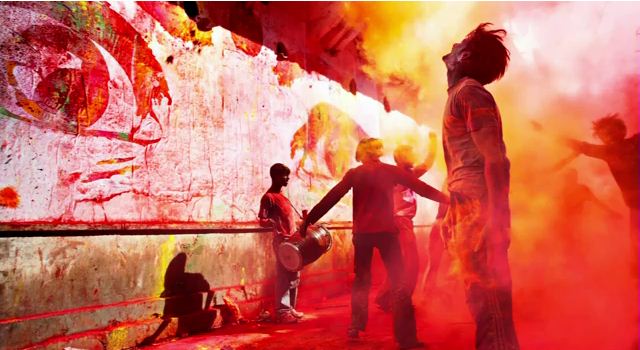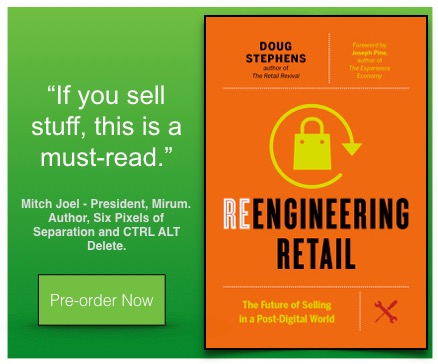By Doug Stephens

Like individuals, retail companies tend to approach each new year by making resolutions to improve their performance. Among other things, these might include incremental improvements in supply chain efficiency, omnichannel capabilities, or perhaps enhancements to customer experience – essentially the corporate equivalent of joining a gym and trying to lose 5 pounds.
Regrettably, as with personal resolutions, these sorts of linear, gradual flirtations with corporate change rarely yield any significant improvements. Moreover, while companies are busy targeting comfortable, incremental improvements, the market, technology and their consumer’s expectations are very likely changing exponentially. And this is a problem. As someone once said, if the disruption outside your organization is greater than the disruption inside it, you’re in deep shit. I’m paraphrasing but you get the point.
With that in mind, there’s tremendous disruption on the horizon. In fact, here’s a small glimpse of what my research suggests retailers should be preparing for in the years ahead.
Retail Reengineered
Whether you’re an online pure play or a brick and mortar chain, the retail market of the near future will be virtually unrecognizable inside of a decade.
Within 5 short years, the current user experience of online marketplaces like Amazon, eBay and Alibaba will begin to look as archaic as a Sears & Roebuck catalog. Virtual and mixed reality technologies will radically evolve the core concept of online shopping and the notion of what an online “store” can be. We will no longer be restricted to ecommerce experiences that resemble digital catalogs. Instead, you may shop for clothing by virtually visiting the homes of celebrities and spending time with them while they show you their favorite items from their own closets. Using haptic gloves, you will be able to reach out and touch the items you’re seeing in the virtual word. You may buy a Drake album by going to a virtual listening party with the artist himself and previewing tracks while he describes the backstory of each song. You may buy food items after virtually attending a cooking class with Gordon Ramsay. If you’re lucky enough, he may even tell you to go fu*k yourself. The point is that the store will cease to be considered a place and will instead become any one of thousands of immersive experiences. Experiences that will allow us to see, hear and even tangibly feel the things we are shopping for in a way we’ve never before conceived possible. A web store will become a physical-feeling thing that we will no longer merely connect to it but rather move within.
While technology will enhance some shopping experiences, it will also make others obsolete. Our cars, appliances, homes, clothing and even our bodies will be constantly connected and information will be delivered to us and our preferred brands and retailers about our day-to-day product needs. This impending replenishment economy as I call it, will virtually eliminate the need to make conscious trips to the store for an astonishing range of items. Routine, regular purchases of everything from detergent to diapers will be managed autonomously requiring only your biometric approval for reorders. You will never again wonder if you have milk in the fridge, shampoo in the shower or how much tread is left on your running shoes. For most these distractions will become a thing of the past.
Speak and Ye Shall Find
Where assistance in making a purchase is needed, it will be just a conversation away. Omnipresent digital assistants will be as common in most homes as televisions are now. These trusted concierges will not only respond to our needs but will learn to anticipate them, tailoring recommendations to our observed product and service preferences, temporal state, and scheduled calendar items. As more and more robust forms of artificial general intelligence are introduced, these devices will increase in their understanding of nuanced demands, and their ability to handle complex problem solving. We will rapidly come to trust the opinions and recommendations of our digital assistants more than we trust our family members.
3D printing, now still largely in the realm of hobbyists and micro-manufacturing startups, will fully commercialize as an accepted element of mainstream manufacturing. Faster printing processes, including liquid interface production, coupled with new dynamic materials will become commonplace in the light manufacturing sector. As consumer co-creators, we will design items like bespoke running shoes at home and pick them up that same day from a location nearby.
Algorithmic fitting and app-driven body scanning will deliver an unprecedented level of fit accuracy when ordering apparel, greatly diminishing the risk for customers and return costs for retailers. Almost everything we order will fit perfectly every time.
Other technologies will enable precipitous declines in the cost of ecommerce operations. The impact of autonomous vehicle technology will be felt first and perhaps most profoundly with widespread government regulation and industry adoption in the commercial transportation market. Amazon, Uber and others will deliver packages using driverless vehicles, terrestrial and airborne drones. In addition, advanced robotics will shrink both the labor and space requirements of warehouses.
The Great Inversion
Given all these advancements, within 15 years, ecommerce will begin challenging brick and mortar for the lion’s share of retail sales in developed economies and within 20 years, the current approximate ratio of offline to online (85/15) will near the point of inversion, with the vast majority of what we purchase coming to us via digital sources. Trips to physical stores will increasingly not be for products, but to have experiences with products that we simply cannot replicate online. Those venturing to the shopping center of the near future will do so for entertainment, hospitality and social interaction coupled with unique, visceral and truly remarkable retail experiences.
The Physical Store As Media
Within 5 years, savvy retailers will cease to regard their physical stores as a channel solely for the distribution of products and will instead see them as critical channels for physical media experiences. This fundamental strategic shift will carry implications for every aspect of how retail spaces are planned, built, staffed, managed and measured. Retail spaces, in essence, will become physical websites – content delivery devices aimed at delivering the highest-octane customer experiences conceivable and driving sales across channels in the process. The retail space will in essence be the immersive gateway to the entire brand story.
The wholesale to retail model for revenue will all but evaporate. Brands across categories will almost invariably sell direct to consumer. Those retailers that survive into this future will either be niche specialty players, deep discounters, vertically integrated brands or experiential retailers.
This fourth class, experiential retailers, will thrive not by eking out margin between wholesale and retail but by staging unique experiences on behalf of the brands they represent and charging upfront to do so. They will design, curate and brilliantly execute shopper experiences that simply cannot be had elsewhere. Robotics will be employed to cover the most banal of in-store operational tasks, freeing up bright, personable humans to delight their customers. For all this, these retailers will command a premium from the brands they partner work for. Yes, brands will cease to be servants of retailers and will instead become their clients and pay handsomely to any retailer that can drive positive brand impressions for their products.
Start A Revolution
In the face of all this change, my one emphatic encouragement to any retail executive reading this would be that this year instead of making fainthearted resolutions, resolve instead to start a revolution, a breakthrough point for exponential change. Challenge core paradigms about how and why you sell what you sell. Deconstruct your current customer experience and redesign it for a post-digital world, where technology is no longer a fascination but a basic consumer expectation to be elegantly woven into your customer experience wherever it adds  experiential value. Let 2017 be the year you push your business model to the very limits of your organizational comfort to discover what’s possible.
experiential value. Let 2017 be the year you push your business model to the very limits of your organizational comfort to discover what’s possible.
After all, success is not a result of predicting the future we get. It comes only when we begin engineering the
future we want.

